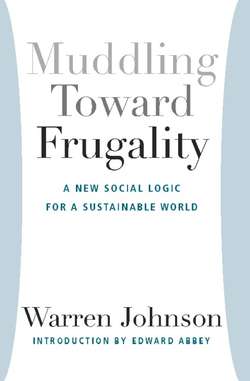Читать книгу Muddling Toward Frugality - Warren Johnson - Страница 18
На сайте Литреса книга снята с продажи.
ОглавлениеCHAPTER III
Advancing Technology, Declining Resources
The history of resource use since the beginning of the Industrial Revolution is a fascinating one. It is also a perfect example of the kind of history that is of far more interest to the cultural ecologist than to the historian. To someone with an ecological perspective, it ties all sorts of basic things together: new tools developed; new methods of livelihood; changes in settlement patterns; plus all the different forms of human behavior that were called forth. All of these things, and many more, would not have occurred without advances in the utilization of previously unused natural resources.
Resource scarcity is not new to industrial society. Although we may look back covetously on the high-grade resources that we have used up, in most cases they were not put to use until traditional materials became scarce, and only then after some form of technological advance was achieved. The resources were not just lying there on the ground waiting to be used. It was necessary to find ways to wrest them from the earth and to put them to use. The striking thing about this process is how frequently technological advance, once it was initiated, went far beyond resolving the original shortage and radically extended the resources available to an expanding industrial civilization. There are enough examples of scarcity averted by technological advance to make understandable the expectation among many people today that this is the way it will always be. It could be a dangerous assumption.
The “Easy” Times
The virgin resources first exploited in the eighteenth and nineteenth centuries were not seen as a wonderful boon by the workers caught up in the Industrial Revolution, yet their development and utilization contributed greatly to our present way of life. A number of the most difficult, even desperate, steps that unlocked the industrial niche were made in England and were brought to this country ready to use.
One of the reasons London became Europe’s largest city in the sixteenth century was that it was able to escape the constraint imposed by the scarcity of firewood by using coal. Found on the beaches below the eroding headlands of northeastern England, these “sea coals” were first used in medieval times, even though wood was considered the superior fuel. Coal was smelly and smoky, and it necessitated the addition of chimneys to dwellings; prior to that, smoke was simply allowed to escape through a hole in the roof.1 The location of coal deposits near the coast made it possible to ship coal to London by water, the only feasible mode of transportation at that time. As wood became progressively scarce, the use of coal expanded and spread to other English cities. A major industry developed.
England is a wet country, and as coal production expanded, the coal mines almost immediately went down below the water table. Crude pumps were used to drain the mines and were usually powered by horses. This was expensive as well as inefficient, and a number of generally unsuccessful efforts were made to develop a “fire” pump that used the material being mined as a source of energy. Not until 1762 did Watt’s reciprocating steam engine appear with its wide usefulness. Think of the changes that it triggered in only a little over two hundred years. Steam rapidly replaced water power as the motive force behind a significantly expanded Industrial Revolution.
Until the eighteenth century, iron was made with charcoal, putting a heavy drain on England’s forests. Numerous early efforts to substitute coke made from coal were unsuccessful. The demand for charcoal compounded the problem already created by England’s growing population and the demands of its navy for ship’s timbers. Through careful selection of the coal used, Abraham Derby finally succeeded in producing iron made by coke, increasing England’s capacity for making iron by a factor of several thousands. Iron and steel became plentiful enough and cheap enough to replace wood in England’s navy, and wood for building was replaced by brick from coal-fired ovens. A whole new era was opening up; the niche of industrial society was being discovered by the first tentative explorers, a process which would soon turn into a flood tide.
